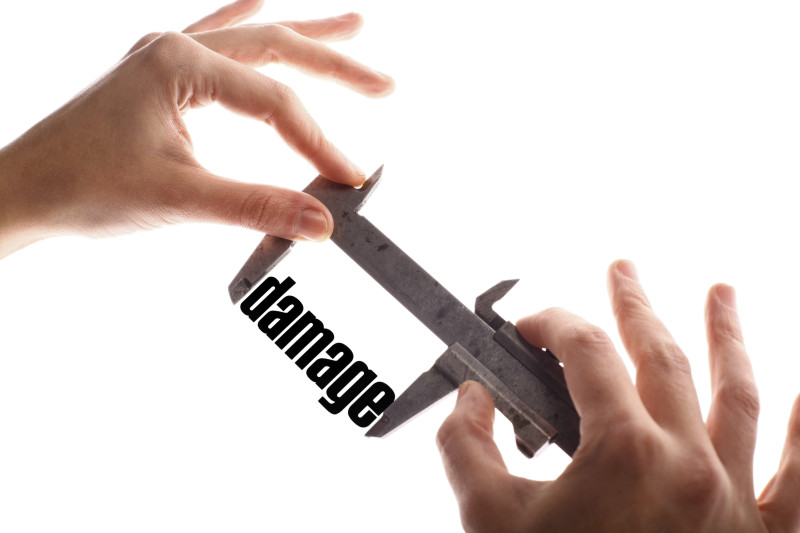I appreciate this subject because in many ways it is mystifying. After all, how in the world can an injured person or an attorney or a jury decide the monetary value of the pain and suffering from a broken leg or a failed artificial hip? If you break your collarbone in a car crash, a crash caused by the negligence of another driver, what is that broken collarbone worth? Is it $75,000? $150,000? More?
Pain and Suffering Damages
This post focuses on one specific area of damages: “pain and suffering” (also known as non-economic damages), which is one classification of recovery intended to compensate an injured person for the actual physical, mental, and emotional suffering caused by the act of negligence. There are other types of money damages in a personal injury case, such as “compensatory damages” for money lost from time out of work, property damages for loss of or damage to an automobile, out of pocket expenses (like the purchase of a wheelchair), and other losses. But those are subjects for other posts. This post will look briefly at pain and suffering damages.
The Legal System Can’t Repair a Broken Body
In many ways the court system is a blunt, primitive, inadequate instrument. It can never take away the pain of physical injury from a person. It can not repair a permanent limp caused by a failed artificial hip or other medical device. All the court system can do is determine who is at fault when an injury occurs, try to measure the total monetary value of the injury, and then award that amount to the injured victim.
So, mystifying or not, in a personal injury case we have to figure out a way to measure the pain and suffering associated with an injured client.
Pain and Suffering Damages Have Evolved Over Time
Decades ago, it was common practice for the lawyers for both sides to place the total medical bills into a formula. The insurance company would then typically offer three times the total amount of the medical bills incurred in the injury suffered by the plaintiff. For example, if a person suffered a broken arm in a negligent slip and fall in a grocery store, and the injury resulted in $10,000 in medical bills, the insurance company might offer the plaintiff $30,000 to settle the case. And if the pain was more severe than in a typical broken arm, the insurance company may well offer more than three times medical bills.
These days, insurance companies scrutinize injury claims much more carefully than in the past. They are much less willing to hand out generous or even reasonable settlement offers in advance of litigation. The work of attorneys representing injured people has gotten more difficult and challenging.
Guiding Principle: Don’t Overreach
Nevertheless, calculating the monetary value for pain and suffering remains a critical part of the process. The first guiding principle is this: don’t overreach. It is absolutely essential for an injured person and her attorney to be reasonable in thinking through a fair amount of monetary recovery for a personal injury claim. I once had a client tell me he believed a scar on his child’s leg which resulted from an act of negligence was worth over a million dollars. I have had other clients who expected thirty, even fifty times the full amount of the medical bills. This is an overreach. And unhelpful in resolving a personal injury case.
Every Injury is Different
That said, no two injuries are the same. In every personal injury action, I sit down and review the entire medical file; I speak with the client many times, and I always try to analyze the client’s very specific “personal” injury. In some cases, three times medical bills is fair and reasonable. In other cases three times meds is not nearly enough. There is no right way to go about this analysis, but in the case of an injury that may last for a month, it may be appropriate to assign a dollar figure to each day of the recovery. In other cases it may work well to assign a dollar value for the injury itself and ignore the number of days it took to recover. If a client is a college student who lost a semester of school, for example, part of the damages may include the value of that lost semester.
What is Fair and Reasonable?
In every case, the guiding light is: “what is fair and reasonable?” If a client overreaches, the insurance company will never make a reasonable counter offer, and at trial the jury may reject the request. On the other hand, an individual does not have to accept whatever “final” offer the insurance company makes. It is important for the plaintiff’s attorney to carefully think through a strong, reasonable number for pain and suffering damages, and then have the strength to stand firm on this amount.
Note: This post is not intended to report the statements of any specific person.
 North Carolina Product Liability Lawyer Blog
North Carolina Product Liability Lawyer Blog


